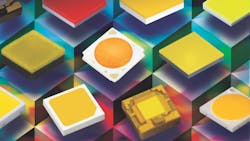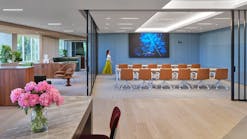Packaged LED architectures pass epitaxy in value to SSL applications (MAGAZINE)
Read our recent coverage on the February Strategies in Light Conference, and you will get a very broad update on LEDs and solid-state lighting (SSL) applications; you will also see one message delivered repeatedly relative to the packaged LED. The energy era is over, specifically relative to LED components. The device that is the essence of our existence at the magazine will be different from here on out. Were you to read through the remainder of this article, without having read the first few sentences, you would likely have grasped a change in process yet perhaps not with the finality of the message we will use here. LED developers and the manufacturers that they work for just aren’t spending much effort to further boost component efficacy, but there are some beautiful things happening in packaged LED architecture. Read on to see.
For most of the last decade, we have written about new packaged LEDs with the focus of the coverage typically on advancements in the material science, epitaxial developments, and packaging improvements — generally with all leading toward more lm/W produced by the new device. Even around mid-decade when we truly started to see LEDs designed for specific applications, the prime takeaway was often still efficacy in the application at hand. We’re not suggesting that LED makers are about to forget about efficacy, but their focus has turned to architectural innovation at the device level for other purposes.
When last we published a feature article on packaged LEDs about eighteen months ago, we noted a trend toward light quality. And we have attempted to champion a cause for improved quality and a renaissance, if you will, where a second generation of SSL products displaces the first with much improved aesthetics.
What this examination of the latest LED components makes clear is that building blocks are falling into place to support such a renaissance. Moreover, application specificity remains as big a part of the story as ever, or perhaps bigger than ever before. Material science still matters as does the semiconductor process and packaging. Still, the industry is experiencing newfound creativity and innovation in device architecture tied to an attempt to deliver a desired outcome in applications.
In that Strategies in Light coverage linked earlier, we discussed a keynote address by Thomas Paterson of lighting design firm Lux Populi. He suggested that lighting design should be undertaken with the goal of coercing desired behavior. The latest packaged LEDs seem as if they are often developed with a similar mission in mind.
SPD tells the story
The best lighting product developers have long understood that an understanding of the spectral power distribution (SPD) of an LED was far more important than a simplified specification like color rendering index (CRI). Indeed, good lighting designers/specifiers have understood the same exact
thing. Today, SPDs are starting to look quite different with the component developer seeking to deliver a desired outcome.
Let’s consider the concept of lighting for health and wellbeing, or human-centric lighting, where a specific light spectrum is intended to coerce positive benefits such as better sleep patterns, improved productivity, or a general lift of mood. There have been simple to extraordinarily complex attempts to achieve such benefits at the SSL system level via two-channel designs to other approaches with five, seven, or more channels of LEDs. But the industry has to be able to realize system designs at reasonable price points and that requirement typically means innovation at the component level.
In many instances, a lighting for health application will be tied to manipulation of the energy in the blue spectral range such as is accomplished in the new Samsung DAY and NITE LEDs (Fig. 1). Blue energy in the morning and even throughout the workday can be a positive as it has been associated with increased alertness. Blue energy at night can delay or disrupt sleep. And of course, phosphor-converted white LEDs are notorious for the blue peak that is evident in many SPD graphs at around 430–440 nm.
Just over a year ago, we saw Bridgelux unveil an LED architecture called Thrive that flattened the blue peak to an extent and delivered an SPD graph closer to that of an incandescent lamp (http://bit.ly/2YeIi1K). The SPD graph for the LED spilled the details of the LED architecture (Fig. 2). Rather than a single blue peak at around 435 nm, the Thrive devices use two blue pumps with the second radiating in the 480-nm range.
Presumably, the dual-emitter design would extend the breadth of the blue energy in the SPD but keep magnitudes at levels below the trigger point for negative impact on the human circadian system. The tradeoff is perhaps a higher-cost device given that the LEDs use two blue pumps. Efficacy would not take a big hit because the dual pumps would be driven at relatively-lower drive currents. And the dual pumps would combine to excite the phosphor, delivering higher energy peaks in the red region that would be welcome at night and that could improve color rendering.
Samsung dual-pump approach
At LightFair International (LFI) 2019, we saw a similar approach from Samsung in the company’s LM302N LEDs that was discussed but not really announced commercially. More recently, Samsung has brought the LED to the commercial market paired with a second device as we wrote recently. The LM302N DAY LED includes a pair of prominent blue peaks while the LM302N NITE LED features an SPD with a minimal peak and an enhanced red energy region. The two LEDs would enable a lighting manufacturer to offer separate lamps or luminaires intended for day or night usage or to offer two-channel designs that could be tuned to the desired mix of the SPDs.
When we first covered the new LEDs, we speculated about how Samsung might have achieved the NITE SPD given that there is only one small blue peak in evidence and that the energy centered in the yellow/red/orange region is much higher than in the DAY version. We’ve received clarification from Samsung on the design. The NITE version uses the same basic dual-blue-pump design. But the phosphor formulation results in a greater magnitude of the blue energy being converted to energy centered in the orange region. Moreover, Samsung says the LED uses a very-narrow-band green phosphor that delivers a broader cyan gap that would contribute to better circadian entrainment. That phosphor was originally developed for use in displays. We’ve covered narrow red phosphors before as a key toward improving color rendering at warmer CCTs with no efficacy penalty. The 2019 LFI story includes one such example. But this is our first encounter with a narrow green phosphor as an LED architectural enhancement.
Nichia dual emitter
Nichia, meanwhile, went a step further in one of its newest LEDs, offering tunability in a single 3030 (30×30-mm) mid-power package. The 757 family is Nichia’s workhorse mid-power LED line that the company has continuously evolved with architectural modifications intended for specific applications. For example, Nichia may not be your first thought when it comes to LEDs for horticultural lighting, but the company does have 757 LEDs with what it considers horticultural spectra.
Originally, the 757 products featured a single emitter in a discrete mid-power package, but the evolution has included devices with multiple emitters. In the fall of 2019, Nichia announced what it referred to as a tunable 757 or, in some places, a 2-in-1 tunable LED. The NF2W757G-MT is intended for lighting for health applications via a tunable CCT and SPD. The package includes one blue pump that is coated in a warm-white phosphor mix that can be seen in photos as a more red region to one side of the square LED package (Fig. 3). A cooler white phosphor covers the entire surface of the mid-power package covering both the warm-white emitter and the second blue pump in the package.
A tunable lamp or luminaire design would drive the two emitters separately. If just the cool-white emitter is driven, the SPD exhibits a prominent blue peak at around 450 nm and a broader yellow, orange, red band that reaches a maximum of about 40% of the magnitude of the blue peak (Fig. 4). If just the warm-white emitter is driven, the blue peak maxes out at around 40% of the red peak energy that is centered just above 600 nm.
Even earlier last year, Nichia had announced the Vitasolis version of the 757 family with the model number NF2W757G-V3F1. That LED was also intended for lighting for health type applications. The architecture minimizes the trough in the cyan region of the SPD and delivers a more continuous and broader energy band in cyan through red wavelengths. That LED would not be ideal for usage at night but would presumably encourage alertness during, say, the work or school day. Vitasolis also won an LEDs Magazine Sapphire Award for 2020 with a score of 4.25 out of 5 Sapphires.
Quantum dots
Osram Opto Semiconductors also took a unique architectural approach to better quality light in an LED that emerged in mid-2019 (Fig. 5). In yet another 3030 mid-power development, the Osram Osconiq S 3030 QD turned to quantum dots mixed with phosphor to convert energy from a blue emitter to broad-spectrum white. You can guess what the QD in the LED model number implies, and the QD technology was developed by Pacific Light Technologies — a startup company that Osram acquired way back in 2013.
We have long heard claims of QD benefits in applications ranging from displays to lighting, and indeed TVs with QD technology used to boost color gamut have been on the market for some time. But in TVs, the relatively fragile nanoparticles are easily protected inside plastic sheets whereas the environment of the converter material being deposited directly on LEDs is far more harsh. It was a device architectural breakthrough to protect the particles that enabled Osram to commercialize the LEDs.
The benefit of the QDs is excellent color rendering at warm CCTs without a compromise in energy efficiency — so yes, there is an efficacy angle. The QDs have a narrower emission band than do red phosphors and therefore don’t waste energy above the range of human visual sensitivity. Longer term, QDs in multiple colors may offer even more flexibility in creative approaches to higher-quality light and spectra for specific applications.
Uniform SPD
And, of course, there are myriad other approaches to color quality. Seoul Semiconductor was an early mover in the area with its SunLike LEDs that utilize a violet pump and a three-phosphor formulation from Toshiba Materials that delivers a very uniform SPD. We covered that technology in our most recent roundup article on packaged LEDs. Seoul has targeted a broad set of applications with the technology. A University of Basel research project revealed improved sleep patterns and heightened daytime alertness for volunteers that lived under SunLike-based lighting.
Lighting manufacturer Soraa was perhaps first to market with a violet-based approach and three-phosphor conversion. That company made its own LEDs for use in lamps and luminaires and even engineered a blue-free SPD for some products. At this point, it’s not completely clear what will happen to the Soraa LED technology as the company was recently acquired by Ecosense.
Mid-power innovation
The other trend you may pick up having read to this point in the article is that innovation is largely coming first to the mid-power LED segment. Some expand a technology to serve other segments. Seoul, for example, offers SunLike in several types of LEDs including chip-on-board (COB) devices. But the initial platform for innovation these days is most often mid-power LEDs.
We have documented the move of many applications to mid-power LEDs over the course of the last five years. Lighting manufacturers, of course, would like to buy lower-cost components so long as said components can deliver the required quality. Mid-power devices cost less than high-power
LEDs for several reasons, including the use of plastic packages. It was the LED manufacturers that engineered plastics to offer high-power-like reliability in mid-power LEDs while also boosting performance.
We won’t backtrack into a big discussion of efficacy here, but it is worthwhile to note the gains LED manufacturers have made. The trend really began to gain steam back in 2016 when Lumileds launched what it called mid-power March with new LEDs in a mix of mid-power footprints.
Most recently, Lumileds announced the Luxeon 3030 HE Plus that we covered in the same news story linked to the Nichia tunable LED. Lumileds is targeting high-ceiling industrial and commercial applications with the LED — applications that value high light levels and excellent energy efficiency. Lumileds said the efficacy exceeds 210 lm/W.
Even Cree has recently touted its mid-power components after focusing mostly on high-power devices and the highest possible performance. The company said the J Series 2835 High Efficacy G Class LEDs deliver 224 lm/W. Those LEDs are fruits of the Cree joint venture with San’an Optoelectronics announced back in 2017.
The mid-power innovation is also encompassing much more complex packages. For example, Lumileds has a 5050-package device that integrates a phosphor-converted white LED along with monochromatic RGB (red, green, and blue) LEDs (Fig. 6). In aggregate, the Luxeon MultiColor Module is a 2.5W device based on a plastic package. And the LED will bring mid-power benefits to dynamic architectural lighting.
New high-power features
We should also mention that there are still new features coming to market in the high-power and also the COB segments. For example, Cree has begun to offer 2200K CCT LEDs in its high-power XLamp XD LED family and in CMA1303 and CMA1306 COB LEDs. The ultrawarm-CCT technologies could be used in several ways. Cree noted that the compact XD16 package supports dense arrays of LEDs and including 2200K in a multi-CCT array would enable a broader tunable range in luminaires. Hospitality applications would be a likely home for such products. Also, some outdoor lighting applications include demands for LEDs below the typical 2700K floor.
Cree also has reminded the industry that innovation can come in manufacturing and business practices. One application where high-power LEDs continue to shine is sports venue lighting (https://bit.ly/3chiQMP). We’ve written going back a decade now about LED lighting coming to football, baseball, and soccer venues. And yes, applied properly, the LED lighting is fantastic for the players on the sports field and the fans in the stands.
Still, it’s often the TV cameras that matter the most and the ability of the lighting to deliver pristine video to the millions of fans at home. But TV cameras don’t in any fashion respond the way the human eye does, so lighting designed for human-centric metrics may not be good lighting for TV broadcasts.
The application led the European Broadcast Union (EBU) to develop a standard metric for TV called the Television Lighting Consistency Index (TLCI) all the way back in 2012. Protocol magazine posted an article explaining the issues a number of years ago.
We won’t go into further details of TLCI here, but Cree is using the metric as another way to bin its LEDs. Specifically, the XLamp XP-L2 and XHP50.2 (Fig. 7) LEDs are available in TLCI bins for consistent TV lighting quality and the LEDs are available in 90–95 CRI for both the humans in the stands and on the field.
Looking forward, the possibilities are almost endless. The gating factor will be features that can deliver return on investment. There will be sufficient demand to surely broaden the architectural scope by the next time we report on the packaged LED space.
For up-to-the-minute LED and SSL updates, why not follow us on Twitter? You’ll find curated content and commentary, as well as information on industry events, webcasts, and surveys on our LinkedIn Company Page and our Facebook page.

Maury Wright | Editor in Chief
Maury Wright is an electronics engineer turned technology journalist, who has focused specifically on the LED & Lighting industry for the past decade. Wright first wrote for LEDs Magazine as a contractor in 2010, and took over as Editor-in-Chief in 2012. He has broad experience in technology areas ranging from microprocessors to digital media to wireless networks that he gained over 30 years in the trade press. Wright has experience running global editorial operations, such as during his tenure as worldwide editorial director of EDN Magazine, and has been instrumental in launching publication websites going back to the earliest days of the Internet. Wright has won numerous industry awards, including multiple ASBPE national awards for B2B journalism excellence, and has received finalist recognition for LEDs Magazine in the FOLIO Eddie Awards. He received a BS in electrical engineering from Auburn University.












